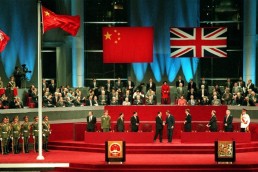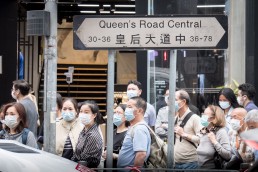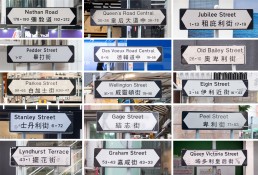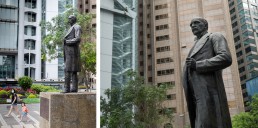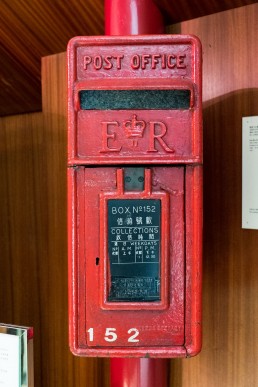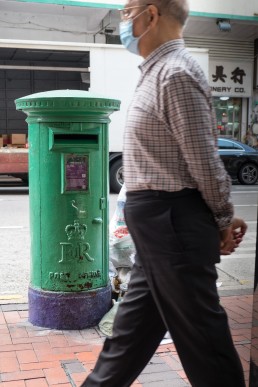With the toppling of colonial-era statues suddenly de rigueur across the globe, why has Hong Kong kept so many souvenirs of the British empire some 24 years after its return of its sovereignty to China?
IN 1996, ONE YEAR BEFORE Hong Kong’s return of sovereignty to China, Pun Sing-lui set about the bronze statue of Queen Victoria that sits in the city’s leafy Victoria Park, beside magnificent Victoria Harbour, with a hammer.
As well as caving in the royal nose, he poured red paint over the British monarch whose reign embraced both Opium Wars. Pun’s “art performance”, the recent arrival from mainland China said, was to protest Hong Kong’s “dull, colonial culture”. He demanded “cultural reunification” with the motherland.
Pun’s attack on the statue was almost universally condemned in Hong Kong, with the 26-year-old slammed as nothing more than a publicity-seeking vandal. Four months later — after a nose job requiring a hydraulic jack, acrylic resin and about £12,000 — the screens hiding Queen Vic were removed. She has serenely watched over the public park ever since.
But for how much longer?
IN THE WAKE OF STATUE toppling around the world and noisy calls to “decolonise” public spaces, on top of the Chinese Communist Party (CCP) decrying the colonial era as a shameful “century of humiliation”, how can it be that Hong Kong maintains many souvenirs of empire some 24 years after Her Majesty’s Yacht Britannia sailed into the sunset?
After all, in other cases where Blighty bid cheerio to its colonies, new rulers often removed statues to reflect changed political realities without much fuss.
“When the post-colonial administration took over, I think they would have quite liked to have got rid of some things,” says Steven Gallagher, a professor at the Chinese University of Hong Kong’s faculty of law, with special interest in cultural heritage, adding that Pun’s desecration of Victoria had “focused people’s attention on their heritage” and made them fearful of a threat to their unique cultural identity.
Gallagher recalls recent words of one of his students: “She said, ‘Even though we were young then, we remember what happened with that statue. We just thought, that’s wrong. That’s part of our heritage.’ The colonial identity is part of Hong Kong for Hongkongers … I think if the government did try to remove [statues] now, there would be a reaction.”
Even British drug dealers are immortalised at Jardine Terrace and Matheson Street — named for the Scottish merchants who founded the company Jardine Matheson in the 19th century to traffic in opium, tea and anything else other that would make a buck
And we’re not just talking statues. Many streets, districts and landmarks in what the tourism authority calls “Asia’s World City” celebrate British royalty. Victoria is honoured everywhere, from the harbour to Victoria Peak. Then there’s Upper Albert Road, Princess Margaret Road, Jubilee Street, Queen Elizabeth and Prince of Wales hospitals, Prince Philip Dental Hospital, Queen Elizabeth Stadium, Prince Edward metro station …
Dozens of locations carry the names of former governors, colonial administrators and military officers, including Nathan, Arbuthnot and Stubbs roads, and Wellington, Gough and Elgin streets. Even British drug dealers are immortalised at Jardine Terrace and Matheson Street — named for the Scottish merchants who founded the company Jardine Matheson in the 19th century to traffic in opium, tea and anything else other that would make a buck.
IN THE RUN-UP TO the handover, there was some apprehension in the uber-capitalistic crown colony for what the future might bring, but talk of dread for authoritarian new overlords marching into town was often exaggerated.
China was loosening up, if gradually, its economy kicking into overdrive. The Basic Law, the post-1997 charter hammered out between Britain and China, promised “one country, two systems”, with Hong Kongers governing themselves for 50 years — which they had not once enjoyed in 156 years under the Union Jack.
Since the change of sovereignty, worries about Hong Kong whitewashing its history have, on the whole, proven unfounded, and its Beijing-beholden government has taken a softly-softly approach to heritage.
When attempts have been made to remove British-introduced landmarks, they have largely been to meet infrastructure needs, as with the removal of Queen’s Pier — the original, long gone, named for Victoria — on the harbour front in 2008 to permit land reclamation.
Gallagher says Hong Kong governments — both the colonial and post-colonial administrations — “have never cared very much for what the people think”, tending to act first and deal with any backlash later. Heritage, he says, is one area where they have learned this roughshod approach does not work, with embarrassing U-turns made to quell popular displeasure when authorities have acted without public consultation.
Though the pier was little more than a utilitarian, concrete canopy thrown up in 1954, conservation-minded protests ensued, and the chastened powers that be committed to store the dismantled structure to reassemble it in another location. Gallagher calls the move a “gesture” not requiring significant investment while “appeasing the people”.
And while there is no special designation for Hong Kong’s colonial statues under the law, he says, with only the British-built Cenotaph protected under the Antiquities and Monuments ordinance, they have been left in peace.
Alongside Queen Victoria — unveiled in 1896 to celebrate her 77th birthday — these include bronzes of King George VI, in Hong Kong’s Zoological & Botanical Gardens, and colony financier Sir Thomas Jackson, made chief manager of the Hongkong and Shanghai Banking Corporation, forerunner of HSBC, in 1876.
Jackson’s is the only statue in Statue Square today, in the heart of what once was the city of Victoria and now the business district of Central. The square had been home to many statues, mostly of royalty, but they were removed during occupation in the Second World War, and shipped to Japan to be melted down. Jackson and Victoria were recovered with the end of hostilities and made it home safe and sound.
THERE HAVE BEEN occasional calls for Hong Kong to exorcise the ghosts of its past, most recently in 2018, when businessman Shie Tak-chung — a local delegate to Beijing’s top advisory body, the Chinese Political People’s Consultative Conference — suggested changing street names as part of a patriotic education drive aimed at youth.
Local commentators spluttered in print that Shie’s call to anti-colonial action was just a self-serving publicity stunt — thus giving him publicity — but it was soon forgotten.
Robert Bickers, a professor of history at the University of Bristol specialising in the British Empire and its relationship with China, says there could be many reasons for streets being left alone since 1997, with practicality perhaps trumping ideology. Changing street names, he says, is “really expensive” and disruptive to everyday life. “All the businesses have to change their cards, their stationary,” he says.
Bickers also believes that when such a changeover of sovereignty has come about peacefully, new powers that be have generally been less excited about ripping down symbols of the old regime.
“It’s not as if there has been a bloody insurgency, and the victors arrive and say we’re pulling down him and getting rid of her. It’s not as if the British, for example, are panicking and thinking, ‘We’re withdrawing now, leaving a puppet government behind that we’re pretty certain is going to fall, so let’s take Queen Victoria with us, or at least move her to safety.’”
If such a handover has been “more bureaucratic and negotiated”, he says, ripping down statues is not a top priority for the incomer. “Top priority is showing that you’re a rational, modern government.”
IN TRUTH, SOME symbols of empire have disappeared over the last quarter century, often in acts of self-censorship. In the immediate run-up to the handover, most institutions holding the Royal Charter voluntarily removed the problematic “R word” from their names, including what are now the SPCA, the Hong Kong Golf Club and the Hong Kong Jockey Club. The notable exception was the Royal Hong Kong Yacht Club, established in 1893.
The club’s early members were British only, later extending to other Europeans, with Chinese not permitted to join until the 1950s. Women, whom Mao Tse-tung proclaimed in 1968, “hold up half the sky”, could not be full members until 1977. Surely the stain of such discrimination would make breaking with the past a sensible move.
But there is nothing in the Basic Law requiring private organisations to change colonial-era names. The government’s attitude appears to be that it’s none of their business, and for a club’s members to decide. (In fact, back in 1996, a majority of the yacht club’s members did support a motion to remove “Royal”, but this fell short by just two votes of reaching the 75 per cent majority required.)
“Our colonial history is still part of our history. Even if we remove all our colonial-style heritage, we cannot make that part of history disappear forever in Hong Kong”
Roy Ng, of the Hong Kong Conservancy Association, speaking to the BBC in 2015
And soon after the handover, Hong Kong’s bright-red post-boxes were not replaced but simply painted green to match those over the border. Fifty-nine of the old cast-iron boxes, however, were embossed with royal cyphers highlighting the reigns of George V, George VI or Elizabeth II.
In 2015, Hongkong Post deemed them “inappropriate”, promising to cover up the royal cyphers with its modern hummingbird logo. Again, there was a backlash.
“Our colonial history is still part of our history,” Roy Ng of the Hong Kong Conservancy Association complained to the BBC at the time. “Even if we remove all our colonial-style heritage, we cannot make that part of history disappear forever in Hong Kong.”
“How many people noticed [the cyphers] before? But as soon as Hongkong Post said we’re going to do this, people got angry,” says South London-born Gallagher.
To its credit, Hongkong Post listened to the dissenting voices. “There was strong public objection,” Ng says today. “So Hongkong Post said they would collect opinions from stakeholders and heritage groups and make a decision.”
That decision, made in 2018, was to leave the royal cyphers visible, as they remain to this day.
AFTER SHIE’S CALL to change street signs in 2018, Gallagher’s understanding is that the government’s attitude was that “everything’s quiet [in Hong Kong], why have you raised this?” And while Shie was accused by some of brown-nosing CCP bigwigs in Beijing, Gallagher says China has maintained its colonial legacy at times because “they use it as part of their narrative” of the exploitation the country suffered in the past. “There’s much more joined-up thinking about the use of heritage in China,” he says.
That said, recent events in Hong Kong — notably the pro-democracy protests that engulfed the city in 2019, and Beijing’s introduction of the new national security law last year, cracking down on separatism and collusion with foreign governments — make it unlikely we will see much more waving of the Union Jack on Hong Kong streets.
“Things are very different now, so we might see a different attitude [to colonial heritage], but I wonder how important it is for them,” says Gallagher, adding that it remains key to Hong Kong people’s sense of identity, and so removal of statues and changing of street names would perhaps be unwise. “It could be the silly thing that tips them over the edge. I would like to think there’s some common-sense there.”
Ultimately, one wonders what item of Hong Kong’s colonial baggage the next publicity-seeker will attempt to steal away.
Will barristers be stripped of their gowns and horsehair wigs? Will the Noonday Gun — celebrated in Noel Coward’s ditty Mad Dogs and Englishmen, and still fired every day by a staffer from Jardine Matheson — be silenced? Will coins adorned with Elizabeth II’s head, occasionally to be found down the back of Hong Kong sofas, cease to be legal tender?
Or, with Mayor Sadiq Khan’s new Commission for Diversity in the Public Realm set to “review” London’s statues, street names and landmarks, could we soon have a bizarre situation where reminders of empire in the British capital are scrapped or hidden, while the same or similar in a Chinese city 6,000 miles away go unmolested? ◉
These words ran in The Critic magazine in the UK in June 2021.
SHARE


